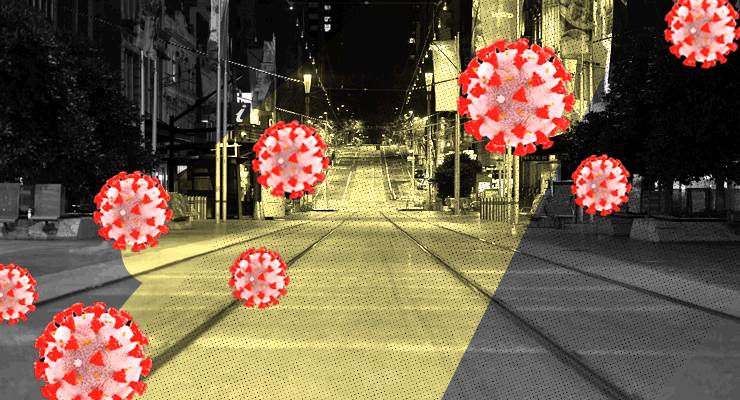
After 112 days in lockdown last year, a massive overhaul of hotel quarantine and improvements in contact tracing, Melbourne was cautiously optimistic it was better prepared for COVID-19 outbreaks in 2021.
What it and other cities across Australia and the world weren’t prepared for was the Delta variant.
Just like Sydney, Melbourne had a brush with Delta in early May this year, when a man who had completed 14 days in quarantine in South Australia returned to Victoria infectious. Victoria went into a 14-day lockdown but soon appeared to get on top of the cases with a small cluster of 20 contained.
But the city’s success was short-lived. Here’s what went wrong.
Bouncing in and out of lockdown
Melbourne’s scare with Delta ended on June 10 when lockdown ended, but freedom lasted only five days.
Another snap lockdown was announced on July 15 after two New South Wales removalists travelled into the state while infectious, moving items without face masks. They weren’t honest about where they’d been and tested positive only after returning to NSW. Victoria’s COVID response commander Jeroen Weimar said “books [would] be thrown” at them when the time came.
“I’m exceptionally frustrated at the pace and transparency of the information coming from the removalists’ exposure,” he said. “That’s been a real matter of concern.”
As well as the removalists, Delta had been spread at an AFL game at the MCG on May 23, (attended by Treasurer Josh Frydenberg although he wasn’t in the exposed area), and through a family from Hume returning from Sydney.
While tensions were high, it appeared the outbreak had been contained, with fewer than 30 new daily cases. This fifth snap lockdown lasted nearly two weeks, prompting anti-lockdown protests with more than 13 million people — about half of Australia — placed under restrictions. Victoria opened up again on July 27.
Again, freedom was short-lived. The cases hadn’t been contained. After just nine days with eased restrictions, Victoria entered its sixth lockdown on August 5. The virus had spread across the multicultural region of Hume where many people work in warehouses and factories.
Tensions began to rise politically, with Premier Dan Andrews hitting out at the removalists and at vaccines given to Sydney to curb the outbreak.
“If we could send it back to Sydney we would,” Andrews said in late August.
Back luck, fatigue and failures
Chair of epidemiology at Deakin University Professor Catherine Bennett tells Crikey Victoria was too quick to lift its restrictions. While previously it had waited for its heralded “doughnut day” of zero new infections, this time restrictions were eased when there were 10 new daily cases.
“Victoria looked at Sydney’s containment, and rushed out of lockdown,” she said. “We had lots of unlinked cases, which is a signal it’s a mature outbreak. By the time they found them, they had been in the community for some time and it was widespread.”
Fatigue played a big factor: Testing rates were low — fewer than half as many tests were being conducted in late September in Victoria than in NSW — and movement trends showed Melburnians were not staying at home as much as in previous lockdowns, with a “slow explosion” of cases.
“The virus had already got its tentacles into the community,” Bennett said.
According to biostatistics and epidemiology expert at the University of South Australia Professor Adrian Esterman, Melbourne experienced a bout of bad luck. And importantly with Delta, it takes only one fatigued person not following the rules to cause an outbreak to skyrocket.
“Victoria was doing quite well at bringing numbers down, but then we had a lack of compliance because people were fatigued and that contributed to case numbers,” he said.
Most COVID rhetoric has focused on the R-value — the average number of people each infected person infects — rather than the K value, the number of people who transmit the disease to others. Esterman says about 10% of infected people cause 80% of infections, often in superspreader events such as parties or gatherings.
“If you’re trying to stop an outbreak, you stop superspreader events, and yet no one seems to focus on them,” Esterman said.
Tensions rise
On August 21, violent protests erupted in Melbourne, this time with up to 4000 attendees after a pause on construction. The direct impact of the protests on transmission isn’t known — Esterman says many protesters probably met up and travelled together, potentially spreading the disease indoors. Anti-vaxxers were also less likely to get tested.
By October 4, Melbourne marked 245 days indoors and became the city with the longest cumulative time in lockdown in the world.
Next: How the bungled vaccine rollout led Australia into lockdown.








Irrespective of tactical and strategic mistakes, Andrews had been consistently undermined by the mainstream private press and the opposition (no evidence that this was co-ordinated??); this may well have been the major contributing factor
The difference between NSW and Victoria has indeed been the press The actions of the kick Vic Victorian Liberals have been a disgrace and have been aimed at the Victorian premier for purely political reasons. The consequences of these actions have included major divisions in society that I believe to be the reason for the marches of violent protestors and threats against public spokespersons .
We have been at war with a virus and society should listen to the opinions of scientists not ratbag online conspiracy peddlers
From Prof Bennett: “We had lots of unlinked cases, which is a signal it’s a mature outbreak.” This locks in to the view of a single outbreak that was allowed to grow, and this is exactly what happened in NSW. But this appearance is also a signal of multiple near simultaneous but actually separate incursions into Victoria of delta-positive persons from NSW, where infection was already rife (due to active mismanagement) and where a so-called ring of steel was not instigated (more mismanagement). Consistent with this view, at around this time SA detected in about a week five separate delta-positive interstate truck drivers; it seems likely that Victoria would have had at least as many given the greater interstate commerce between NSW and Victoria. Also consistent with the multiple incursions notion, but not so consistent with the single mature outbreak notion, is the dramatically faster rate of increase in number of cases in Victoria compared to the NSW outbreak: if one outbreak takes a week to grow from one person to, let’s say, 30, with three simultaneous incursions you might expect in a week there might be 90 cases. So Victoria would be faced with a wack-a-mole problem made more difficult not only because the mole bobs up and down faster (it’s a delta-mole), but especially because several delta-moles appear at the same time. The previously successful lockdown measures could not combat this scenario, you’d need some addition armaments, which fortunately appeared (eventually) in the form of the vaccine roll-out. But nobody’s out of the woods quite yet.
AS we locked down Sydney picnicked and only when numbers were out of control did they go into partial lockdown . Victoria allowed its allocated vaccine to be used in NSW but unbeknown to us the PM for NSW had a stash which he was able to divert into an alternate vaccination cohort the Chemists. Not Gladys but the great marketer probably the pointy end of all our problems including the rest of Australia by being last in the Phizer Queue after refusing to discuss our needs and then coming last in the queue’
We were extremely lucky to be able to obtain near out-of-date excess vaccines from better-managed countries to get us out of the problems caused by great marketers’ lack of leadership.
“AS we locked down Sydney picnicked and only when numbers were out of control did they go into partial lockdown.” But the Victorian outbreak has been as bad or worse than Sydney’s, so what does that say about the effectiveness of the tougher measures? We should be evaluating strategies and policies based on outcomes, not by perceived measures of toughness.
Had the PM for NSW and the then Premier not been so obsessed with the idea that a lockdown was the last option NSW would not have become a breeding ground for COVID .
The initial Victorian outbreak followed poor decision-making.The Victorian government had less than two days to come up with a plan to handle an unprecedented quarantine requirement. Aircraft carrying the passengers to be in isolation were in some cases already in the air.
The wrong decisions were made granted but the majority of deaths in Victoria occurred in nursing homes under the control of the federal government. Many of these homes were understaffed and had been for years and despite numerous reports, no action was taken to improve the staff ratio.
NSW has been the source of most of Australia-wide and New Zealand outbreaks.From the disgraceful inability to properly assess and handle the Ruby Princess departing passengers despite the Diamond Princess being headline news around the world to the inability to differentiate the difference between Crossways Hotel and Crossroad Hotel and allowing Infected aircrew to be transported by the next available unregulated cab to quarantine And other breeches of Safe Operating Procedure.
NSW was able to mitigate the problems caused by bad management as previously stated by our Great PM making another unilateral decision to redirect a contracted supply of vaccine in secret much like the Submarine deal
At last,someone on the media recognises the reduced compliance with lockdown restrictions in Melbourne with successive lockdowns. Not aided, at all, by the Victorian members of the Federal Cabinet acting as the political opposition to the State Government
Fact is Australia was and is about 6 months behind the curve compared with EU nations, UK etc. with their more timely vaccine procurement, roll outs etc. backgrounded by similar if not higher rates of infection when vaccinations commenced; the issues for Australia is why were we so slow and complacent?
Further, Australia could do well in not replicating the UK and US and their cliched Kochian ‘freedom (& liberty) days’ with (sub-optimal) protective measures not retained e.g. mandates on transport for masking, evidence of vaccination to enter venues etc.; UK is now considering a return to some restrictions as are many EU nations.
We were slow and complacent because we refused to believe the coronavirus could survive airborne transmission. Or at least our federal government did. It was known overseas, but for some reason – perhaps that clown telling us all “it’s not a race” had something to do with it – we chose to ignore that information and treat the virus the same way we had been (successfully) treating it up until then. You know: wash your hands, keep your distance; these measures (plus masks) weren’t enough to stop delta.
And we should have known that months prior.